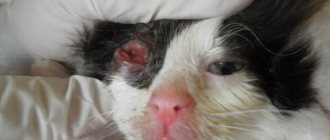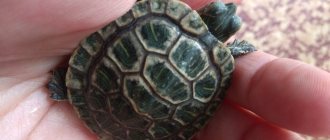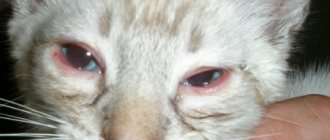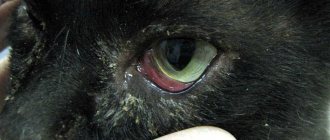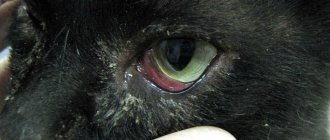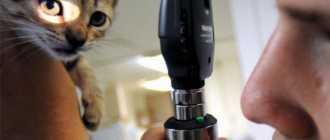13395Pavel
4
Ten days after birth, the kittens’ eyes begin to open, initially narrow slits appear, and then two small buttons glow like beads. This is a normal process. But what to do when the kitten’s eyes do not open? This phenomenon causes concern among owners.
Watching the little beads open is just a pleasure. To begin with, tears appear in the inner corner, then a small crack forms, which increases every day. As a result, small shiny buttons appear. But if your eyes are difficult to open, is it worth doing anything?
Normal timing of eye eruption in kittens and factors that can slow down this process
It is believed that normally, kittens' eyes begin to erupt seven to ten days from the moment they are born. By about the second week after birth, the eyes should be fully open. But this rule also has its exceptions. Sometimes the teething process takes noticeably more or less time:
- Breed characteristics. In cats of the Rex and Sphinx breeds, their eyes begin to open within two (!) days after the babies are born.
- The degree of illumination of the place of detention. Interesting fact: if sunlight constantly falls on a basket with kittens, then the process of eye eruption in such animals can take three weeks or more. But if pets are in a constantly darkened place, their eyes will open noticeably faster.
- Cats of long-haired breeds develop noticeably slower . This also applies to the speed of eye opening, which is much slower in such animals. In particular, the eyes of “Persians” can erupt by three weeks from the moment of birth, and this is considered a variant of the norm.
- Duration of pregnancy. If the kittens are born on time, then their eyes will open on time. But in case of prematurity or postmaturity, this period will certainly increase.
When do kittens' eyes open?
Newborn kittens are small blind and deaf lumps that cannot fully move, except to crawl weakly and turn their heads from side to side.
However, even such babies cannot be called completely helpless, since kittens from birth have relatively well-developed senses of smell and touch. But until the ear canals and eyes open, the babies will remain not too active, depending entirely on the mother cat. How many days do kittens open their eyes after birth? Most often, the process of opening the eyes begins in cats on the 10-12th day of life.
, but at the same time, some pets gain sight a little earlier, while others can remain blind up to 3 weeks of life. Thus, in Siamese cats, representatives of the Devon Rex and Cornish Rex breeds, as well as in hairless sphinxes, the eyes can open as early as 2-5 days of life, but in Ragdolls and Maine Coons - on days 16-19. By the way, kittens begin to hear at about the same time when they begin to see (i.e., on average, after the 12th day of life). Thus, baby kittens do not stay in the silent darkness for so long.
Based on the following data, you can roughly predict when it will be time for kittens to open their eyes:
- Mother's age
. Young first-born cats and very old cats often give birth to very weak kittens. They begin to see relatively late, gain weight slowly, and are susceptible to various diseases due to weak immunity. Kittens from healthy middle-aged cats are the earliest to grow stronger and become sighted; - Length of pregnancy in a cat
. The less time a cat spends carrying kittens, the later they will begin to open their eyes. On average, the duration of gestation in females is about 63 days, but sometimes cats give birth to premature babies; - Gender of the kitten
. In females, the eyes begin to open a couple of days earlier than in males from the same litter; - Length of coat
. Short-haired kittens begin to open their eyes a little earlier than their long-haired counterparts (for example, almost hairless Sphynx kittens are sometimes born with their eyes slightly open, while the same fluffy Persians remain blind for the first two weeks of life).
We have already found out that kittens open their eyes after birth on average 10-14 days
. Blinded eyelids do not open completely immediately. At first, a small slit appears between the lower and upper eyelids, but after about a week it will be possible to see what the shape of the baby’s eyes will be.
In all kittens, in the first week after the opening of the eyelids, the eyes remain cloudy and their color is gray-blue.
.
During this period, small animals do not clearly see everything that is happening around them. But they can already distinguish light from darkness, large objects from small ones. The approximate permanent (adult) eye color of a kitten is established only by the 3rd month of life
. And already at 6 months you can accurately find out what color your pet’s eyes will be.
When is it time to sound the alarm?
Delayed eye eruption should be suspected in the following cases:
- If the kitten’s eyes have not opened within three weeks from the moment of birth (more precisely, if no slits or other signs of their eruption are visible at all).
- In cases where swelling is noticeable in the eyelid area, exudate is visible and other signs of the development of infectious diseases are noticeable.
- It is also worth notifying your veterinarian if the kittens are constantly squeaking or showing other signs of anxiety. It is quite possible that their eyes do not open due to a lack of nutrients (the mother has little milk; this is not always immediately noticeable).
Eye injuries
Most often, a cat does not open one eye when a grain of sand, speck or any other foreign body enters it. Movement of the eyelids and eyeball causes pain, so the animal prefers to keep the eye closed. A characteristic symptom of this phenomenon is profuse lacrimation from a closed eye. Over time, tears will wash away the debris from the eye, and the cat will no longer keep it closed. This usually happens after a few hours.
Another likely reason that a cat’s eyes won’t open is an injury while washing itself. If an animal vigorously rubs its muzzle with its paws, it may accidentally damage the mucous membrane of the eye, or get hair under the eyelid. This causes discomfort, so the cat keeps the eye closed until the mucous membrane is restored or tears wash out the hair.
Cats often come into conflict with their relatives. If a cat comes back from a walk dirty, wounded and does not open one eye, it means he has experienced a serious fight with a competitor for his territory. In this case, it is recommended to observe the behavior of the animal. If the cat feels well, despite the injuries, demonstrates a normal appetite and normal behavior, there is no cause for concern. After a short time, the mucous membrane will recover and the cat will open its eye again.
The alarm should be sounded if wounds are visible around the eye, and blood, mucus or pus oozes from under the closed eyelid. If you notice such symptoms, your cat should be taken to the veterinarian as soon as possible to avoid loss of vision. Sometimes conflicts with relatives lead to severe injuries, and bleeding from a closed eye may indicate severe damage.
You might be interested in: Should I be concerned if my cat is constantly licking itself?
If the cat's right eye does not open, it is recommended to wait several hours. In most cases, a cat will keep its eyelids closed due to a common household injury. If there is no foreign discharge, and only slight lacrimation is observed, there is no reason to panic. If a cat keeps its eye closed for more than a day, you should show the animal to a veterinarian. It may be necessary to remove the foreign body. To prevent infection of the damaged eye, the doctor will prescribe antibacterial drops, solution or special gel.
Eye pathologies in kittens
It is possible to decide what to do if one or both eyes of a kitten do not open only after establishing the cause of this phenomenon. One eye may remain closed as a result of injury, a foreign object, or an infectious agent.
An experienced doctor can easily determine this, carry out treatment and give recommendations for further care of the animal at home.
But some pathologies require surgery and long-term therapy.
Fusion of eyelids
The reason that the kitten does not open its eyes may be fusion of the eyelids. This pathology can be congenital or acquired.
A sign of congenital fusion is the presence of a thin strip of skin, which is clearly visible when the eyelids are stretched.
Acquired pathology is characterized by the formation of scar tissue at the site of fusion. It can be evenly present both throughout the entire eyeball and in individual areas.
Factors that provoke acquired fusion are:
- injuries to the eyelids or conjunctiva;
- chemical or thermal effects on the eyes;
- ulcerative processes resulting from infectious lesions or inflammation.
With timely initiation of treatment, acquired fusion of the eyelids is eliminated with the help of massage with the preliminary application of boron Vaseline.
Congenital pathology or strong acquired fusion is eliminated surgically. To do this, tissue dissection is used with a scalpel under local anesthesia, followed by regular treatments with boric vaseline until complete recovery.
Some clinics use an electrothermal cautery to cauterize the edges of wounds. Such treatment prevents relapses of the disease.
A more serious pathology is the fusion of the eyeball with the eyelids. Partial fusion in most cases is eliminated surgically, followed by cauterization and treatment with antibiotics, proteolytic enzymes, and boric petroleum jelly.
Vision is impaired, but the animal retains the ability to distinguish objects and move freely in space. With total fusion of the sclera and conjunctiva, the cat becomes blind.
Another complication of conjunctivitis and other severe inflammatory processes is blepharophimosis. This pathology is characterized by shortening of the palpebral fissure due to the proliferation of connective tissue in the corners of the eyes.
Surgery is used to eliminate it. With subsequent full care, experts give a favorable prognosis.
Conjunctivitis
The reason why a kitten does not open one or both eyes may be conjunctivitis (inflammation of the mucous membrane).
Depending on the etiology and symptoms, this disease is of 4 types:
- Catarrhal conjunctivitis, which develops as a result of allergic reactions, injuries and foreign objects entering the organs of vision. Its clinical signs are swelling of the eyelids and constant discharge of catarrhal exudate in the form of clear mucus.
- Purulent conjunctivitis develops after the penetration of pathogenic bacterial microflora, as well as viruses or chlamydia. Purulent exudate is released from the eyes, crusts appear on the eyelids, which do not allow the eyes to open, especially after sleep.
- Follicular conjunctivitis occurs when lymphatic follicles are involved in the inflammatory process in addition to the conjunctiva. In kittens, dried crusts of purulent exudate appear on their closed eyes. After their removal, you can notice that a thin cloudy film forms on the cornea. Pets develop photophobia, nodules appear in the corners of the eyes, and the animal gradually loses vision.
- Phlegmonous conjunctivitis, in which the third eyelid and other eye tissues are involved in the inflammatory process. The eyelids become very swollen, purulent exudate constantly flows from the corners of the eyes, causing maceration of the skin and hair loss. If left untreated, the kitten's body temperature may rise and become life-threatening.
Methods for treating eye diseases in cats
If your cat squints or squints, it needs to be seen by a veterinarian. The specialist will find out the cause of this phenomenon and prescribe treatment.
However, not everyone has the opportunity to immediately take their pet to the clinic. In this case, it is recommended to examine the animal at home and provide first aid.
To do this you need:
- check whether a foreign body has entered the eye;
- rinse the damaged visual organ with saline solution or warm boiled water;
- Carefully remove the pus, moving from the outer corner of the eye to the inner.
Without the doctor's permission, it is prohibited to use antiseptic solutions or antibiotics for rinsing and treatment. Medicines, eye drops and ointments are prescribed only by a veterinarian after diagnosis.
Severe cases require surgery and suturing. This treatment is carried out in a hospital setting.
What to do if a kitten does not open one eye
Owners need to know what to do when kittens do not open their eyes after all acceptable periods have passed. If only one eye of the kitten is open, then this is a signal for immediate action, since the baby has obvious problems, and he cannot solve them on his own.
At home, kittens' eyes can be washed with chamomile decoction, saline solution or a strong infusion of black tea without additives. Next you need to act according to the following algorithm:
- moisten a cotton pad (napkin) in the prepared warm liquid;
- fix the kitten's head by turning its belly towards you;
- Apply the tissue to your eye for a few seconds;
- gently (without pressure) move it in the direction from the outer to the inner corner of the eye;
- if necessary, repeat the last step 2-3 times.
If this does not help or the eyes, after washing, stick together again and stop opening, then you need to contact a veterinarian.
Important! It is forbidden to use antibacterial, antiviral or antifungal solutions yourself to help the kitten open its eyes.
Do not use force to open the kitten's eyes, as this can lead to injury and further development of blindness.
Signs and treatment of infectious diseases that are accompanied by a closed eye
It happens that a cat’s right eye does not open for more serious reasons - when it is affected by a virus or infection. It is not difficult to determine the danger, because diseases reveal themselves with vivid symptoms that are easy to recognize with a little observation. The following signs indicate a dangerous disease:
- the animal refuses to take food;
- lethargy and apathy appear;
- the cat's eyes may become sour;
- a cloudy, foul-smelling fluid flows from the closed eye;
- infection spreads to other organs - pus is discharged from the nose;
- There are sharp temperature changes.
Veterinarians warn that in such cases it is forbidden to influence the disease yourself, use medications or use gentle herbal remedies. Only timely treatment of a pet will help preserve vision, health, or even life.
Antibacterial drugs, special eye wash medications, and immunity-boosting drugs are usually prescribed. The course of treatment is prescribed by a veterinarian based on the age of the animal, the characteristics of the disease, and the presence of additional signs. Cat owners need to remember that the responsibility for the health and well-being of their pet falls entirely on their shoulders. Only careful observation of the animal, timely contact with a veterinarian and strict adherence to all specialist recommendations will help prevent dangerous consequences.
Kitten can't open his eyes
Ten days after birth, the kittens’ eyes begin to open, initially narrow slits appear, and then two small buttons glow like beads. This is a normal process. But what to do when the kitten’s eyes do not open? This phenomenon causes concern among owners.
Watching the little beads open is just a pleasure. To begin with, tears appear in the inner corner, then a small crack forms, which increases every day. As a result, small shiny buttons appear. But if your eyes are difficult to open, is it worth doing anything?
About the vision of cats
To clarify the problem and correctly assess the current circumstances, the owner must know about the structure of the kitten’s eye. In relation to the human organs of vision, the eye size of pets is much larger. The retinal area also contains nerve endings or rods. There are almost 7 times more rods than cones, which indicates that furry friends have much better vision than humans, so they see well in the dark.
The round shape of the eyeball with the lens located at the center helps to expand the viewing angle. The eyes are protected from the effects of external factors, that is, foreign bodies entering the eyelids and mucous membranes. Moreover, cats have three eyelids, and this only enhances their protection.
Research has found that cats see the world in color, and not in black and white, as many people think. It’s not for nothing that the kitten likes to sit next to the screen when watching TV.
Reasons for not opening your eyes
Newborn fur babies develop quickly, and their eyes usually open within 1-2 weeks. But there are exceptions when babies remain with their eyes closed for more time.
From living conditions. If babies are exposed to light, then
Source
